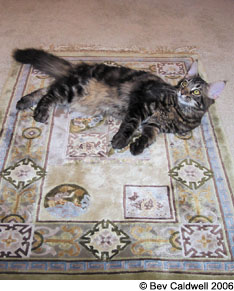I recently received a letter questioning why a cat would choose to eliminate on an Oriental carpet. If we cannot understand the exact reasons, well then, can we at least fix this problem?
There are many potential reasons for a cat to eliminate on a carpet. As always, a medical diagnosis is needed. But once your cat receives a clean bill of health, one possibility to consider is marking behavior. Check for evidence of social strife within the home. Could there be outside stressors such as neighborhood cats that prowl around your yard? Consider the rug itself. Has it recently been cleaned? Was it previously owned, and did that family have a cat? Are deodorizers applied in an attempt to keep the rug looking or smelling fresh? Any of these factors can trigger marking.
More often, cats seem simply to prefer the Oriental rug to the litter box. Do they mistake the floral pattern for a garden? That might be a good topic for a research project, but as far as I know, pattern detection or preference has not been studied in this context.
How the Problem Can Start
Many cats seem to like the absorbent nature of the carpet itself. Urine disappears, and feet remain dry. Some cats behave as though the texture of the litter is unpleasant. You may notice your cat shaking his paws to rid himself of any residual grains immediately after leaving the box. If the substrate inside the box is aversive, a cat will seek a new substance. Why not use the carpet, the cat ponders? Then there are clean, dry paws all around.

234
In some cases, the Oriental rug may be used as a matter of convenience. Many people keep litter boxes on one level of the house, not at all close to the cats sunbeam or cat tree. So, upon waking up from his nap, a cat has a choice. He could trek up or down the stairs, all the way to the box, then travel back to the living room for the rest of his afternoon. Or he could just eliminate on the rug that his owners conveniently placed beside his sofa.
Consider too that there may be a deterrent to using or accessing a litter box. If litter boxes are dirty, then a cat may find a large, clean rug appealing. Most cats do not seem to prefer to eliminate time after time on a dirty surface.
Then again, the box may be as clean as can be, but if the path to the box is not a pleasant one, an alternate location may be selected. For instance, if the litter box is in a spare bathroom and the only route to the bathroom is through the childrens play center, then a cat may look once, find the roadblock overwhelming, and head out in another direction. The new path may lead to the Oriental rug, particularly since Orientals are often found in rooms that do not receive high traffic.
And herein lies the reason why this frowned-upon elimination behavior, once tested, is likely to continue: Exquisite carpets are often placed in rarely used rooms. It may be days or weeks after the deposit before the urine spots are discovered. Furthermore, the lovely prints mask any discoloration. Urine may only be discovered by a person with a sensitive nose or bare feet.
By the time the full scope of the problem is discovered, the new unacceptable behavior pattern has been established. The cat has received positive reinforcement for his selection of the Oriental carpet as a bathroom. It is a win-win situation. He is able to achieve physical relief (emptying his bladder) using a preferred substrate (one that keeps his feet clean) in a convenient, quiet location.
What to do? First, try putting a litter box in the immediate area. It will not necessarily be pleasant for the people, but rest assured that it should only be a temporary inconvenience. Wait for the cat to use this litter box regularly. Then, slowly move the box away to a more socially acceptable area. At this point, if the cat still returns to the Oriental, then, in addition to providing a box, it may be necessary to make the carpet a less appealing choice. In addition, a litter box preference test may be needed. This will tell us what your cat thinks is wrong with the box itself. Once the problem is remedied, the cat should choose the newly remodeled box for his future elimination.
If your cat still insists on choosing Orientals, please make a return call to your veterinarian. A thorough behavioral work-up can be done, and harmony will surely be restored.



